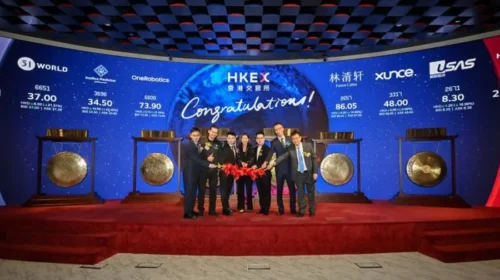Linklogis deepens its blockchain bet to make supply chain finance great again

The provider of digital supply chain financing services will use XRP Ledger to settle digital transactions as it continues to reel from China’s long-running real estate slump
Key Takeaways:
- Linklogis will integrate its platform onto XPR Ledger’s blockchain network to settle international trade-related digital asset transactions
- The supply chain financier has been active in using blockchain, with related services becoming its largest revenue source
By Warren Yang
It’s no secret that cryptocurrencies have the potential to revolutionize financial transactions. But one lesser-known area that can also benefit nicely from digital asset technology is supply chain finance. At least that’s what Linklogis Inc. (9959.HK) seems to believe, as it looks past its traditional reliance on China’s slumping property sector to try to find its way back to growth.
Late last month, the company, which operates online platforms for supply chain finance, signed a strategic partnership to use XRP Ledger (XRPL) for some of its services. Under the collaboration, Linklogis will integrate its supply chain finance platform onto XRPL’s “mainnet,” a fully functional blockchain network, to “enable the circulation and cross-border settlement of digital assets backed by real-world trade flows,” according to the announcement.
That basically means that Linklogis will use XRPL to tokenize invoices for real international trade transactions. This can significantly enhance supply chain finance by making the process more efficient and reducing the potential for fraud. That would boost Linklogis’ services that are already designed to make life easier for suppliers and their buyers by digitalizing transactions. While all that sounds good conceptually, we should also point out that neither Linklogis nor XRPL gives a detailed explanation on how their collaboration will work.
In supply chain finance, a company, sometimes called an “anchor,” uses unpaid bills it owes to its suppliers to help them obtain financing, leveraging its own creditworthiness. Both the anchor and suppliers benefit because the former gets more time to pay its bills, while the latter can get cash to finance their operations. Linklogis sits in the middle of that process, using its own funds or loans to purchase unpaid bills at discounts, and then netting small profits when the bills are finally paid off.
Blockchain can do many things in supply chain finance. It’s a decentralized and highly transparent technology so it can make transactions easier to trace. This is particularly important in preventing fraud and resolving disputes. Blockchain can also help reduce costs because it can eliminate a lot of manual work. And the technology can make transactions faster by eliminating the need for intermediaries.
Linklogis already uses blockchain for its “Multi-tier Transfer Cloud” product, which converts receivables from transactions between small and medium-sized suppliers and their larger customers into digital payment obligations (digipos). Linklogis started offering the service only in 2017 but it’s now the company’s biggest revenue source.
In the first half of this year, the volume of supply chain assets processed on Linklogis’ Multi-tier Transfer Cloud platform jumped 54% year-on-year to account for nearly two-thirds of the company’s total transactions, up from about 54% a year earlier.
No small deal
Although details are scarce for now, it’s reasonable to expect the collaboration with XRPL will help Linklogis further deepen its blockchain-based offerings. And XRPL is no small deal in the crypto universe. It was created back in 2012 under the concept of “bitcoin without mining.” A large pre-determined amount of XRPL’s native crypto coin, XRP — also known as Ripple — was created at the launch of the currency’s ledger to eliminate the need for adding new supply through energy-intensive, costly mining.
Because of this difference, XRP transactions are faster and cheaper, which makes it attractive for real-time international payments. In fact, Ripple is one of the top three cryptocurrencies in terms of market capitalization, along with bitcoin and etherium. So Linklogis’ decision to work with XRPL makes a lot of sense.
Linklogis and XRPL will explore further collaboration in areas like stablecoins, smart contract–based trading of supply chain assets and the convergence of blockchain and AI in global trade finance.
Linklogis is expanding its crypto-related capabilities as it tries to revive its fortunes that have slumped due to its heavy reliance on businesses related to China’s real estate sector. It has been trying to diversify its customer base, but hasn’t made significant progress. In the year to June, infrastructure and construction companies still accounted for a third of the total volume of the company’s transactions, although the proportion directly tied to the real estate sector continued to decrease, to less than 10%.
So, increasing business volume through blockchain-based services can be important for Linklogis to become more efficient. The problem here, though, is that margins on such services seem bad since costs for digitalized transactions are low, meaning that fees for them are also low. But then, low costs probably are precisely what lure businesses to Linklogis’ Multi-tier Transfer Cloud. It’s a case of sacrificing margins for volume growth.
Vividly reflecting this dilemma, Linklogis’ revenue — and its gross profit margin — shrank in the first half of this year despite the big increase in demand for the Multi-tier Transfer Cloud product. As a result, its net loss widened by 58% year-on-year to 378 million yuan ($53 million) during the six-month period.
Linklogis will need huge growth in transaction volume to overcome this margin problem. The latest blockchain deal looks promising, but it remains to be seen whether it’ll bring quick results, especially in the current economic environment in China.
Investors still seem rather optimistic, given that Linklogis shares have gained more than 50% in the past month, including a rally since the announcement of the collaboration with XRPL. That said, their valuation remains modest, with a price-to-sales (P/S) ratio of 5.7, although that’s well ahead of multiples for consumer-focused online financiers like FinVolution (FINV.US), which trades at a P/S ratio of just 1.
Linklogis clearly isn’t out of the woods yet as it continues to diversify from a Chinese property market shows no signs of improving anytime soon. But investors may not want to write off the company just yet, as its focus on blockchain technology may eventually provide a firm foundation for a longer-term revival.
To subscribe to Bamboo Works weekly free newsletter, click here





